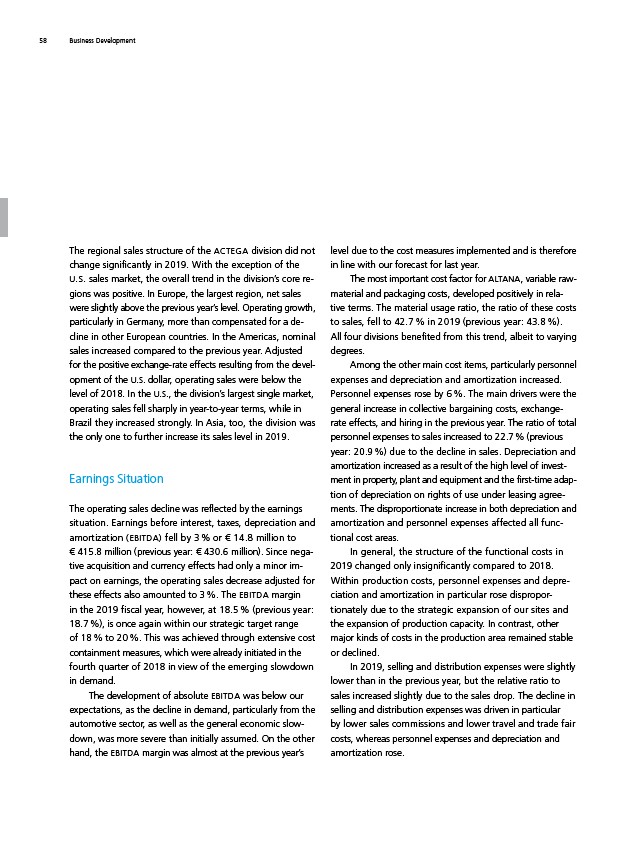
The regional sales structure of the ACTEGA division did not
change significantly in 2019. With the exception of the
U.S. sales market, the overall trend in the division’s core regions
was positive. In Europe, the largest region, net sales
were slightly above the previous year’s level. Operating growth,
particularly in Germany, more than compensated for a decline
in other European countries. In the Americas, nominal
sales increased compared to the previous year. Adjusted
for the positive exchange-rate effects resulting from the development
of the U.S. dollar, operating sales were below the
level of 2018. In the U.S., the division’s largest single market,
operating sales fell sharply in year-to-year terms, while in
Brazil they increased strongly. In Asia, too, the division was
the only one to further increase its sales level in 2019.
Earnings Situation
The operating sales decline was reflected by the earnings
situation. Earnings before interest, taxes, depreciation and
amortization (EBITDA) fell by 3 % or € 14.8 million to
€ 415.8 million (previous year: € 430.6 million). Since negative
acquisition and currency effects had only a minor impact
on earnings, the operating sales decrease adjusted for
these effects also amounted to 3 %. The EBITDA margin
in the 2019 fiscal year, however, at 18.5 % (previous year:
18.7 %), is once again within our strategic target range
of 18 % to 20 %. This was achieved through extensive cost
containment measures, which were already initiated in the
fourth quarter of 2018 in view of the emerging slowdown
in demand.
The development of absolute EBITDA was below our
expectations, as the decline in demand, particularly from the
automotive sector, as well as the general economic slowdown,
was more severe than initially assumed. On the other
hand, the EBITDA margin was almost at the previous year’s
level due to the cost measures implemented and is therefore
in line with our forecast for last year.
The most important cost factor for ALTANA, variable raw-
material and packaging costs, developed positively in rela-
tive terms. The material usage ratio, the ratio of these costs
to sales, fell to 42.7 % in 2019 (previous year: 43.8 %).
All four divisions benefited from this trend, albeit to varying
degrees.
Among the other main cost items, particularly personnel
expenses and depreciation and amortization increased.
Personnel expenses rose by 6 %. The main drivers were the
general increase in collective bargaining costs, exchange-
rate effects, and hiring in the previous year. The ratio of total
personnel expenses to sales increased to 22.7 % (previous
year: 20.9 %) due to the decline in sales. Depreciation and
amortization increased as a result of the high level of investment
in property, plant and equipment and the first-time adaption
of depreciation on rights of use under leasing agreements.
The disproportionate increase in both depreciation and
amortization and personnel expenses affected all func-
tional cost areas.
In general, the structure of the functional costs in
2019 changed only insignificantly compared to 2018.
Within production costs, personnel expenses and depre-
ciation and amortization in particular rose dispropor-
tionately due to the strategic expansion of our sites and
the expansion of production capacity. In contrast, other
major kinds of costs in the production area remained stable
or declined.
In 2019, selling and distribution expenses were slightly
lower than in the previous year, but the relative ratio to
sales increased slightly due to the sales drop. The decline in
selling and distribution expenses was driven in particular
by lower sales commissions and lower travel and trade fair
costs, whereas personnel expenses and depreciation and
amortization rose.
58 Business Development